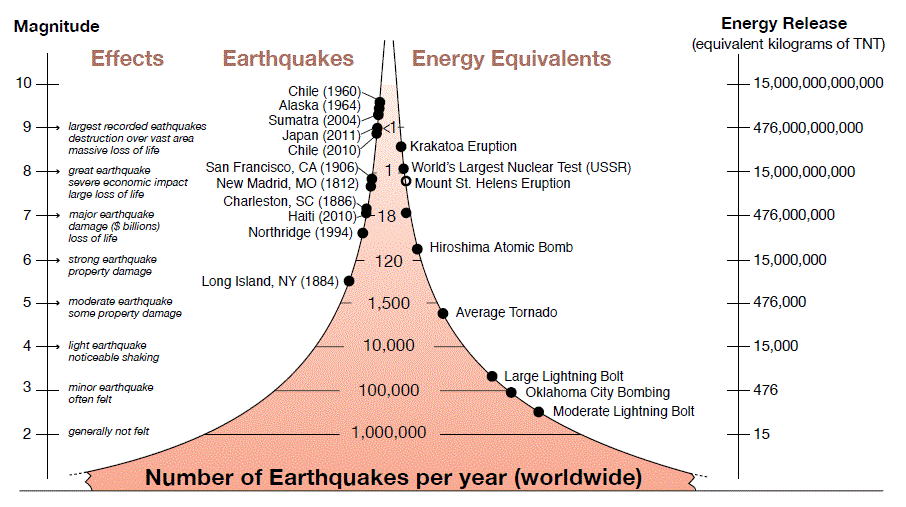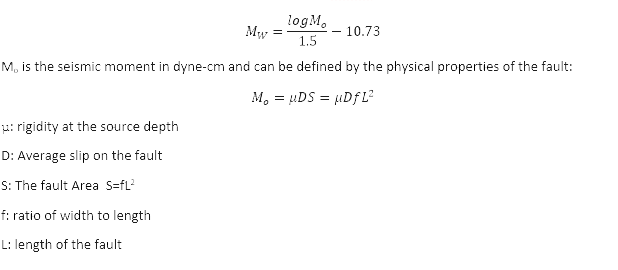
Earthquake SizeThere are three basic ways to describe the size of an earthquake: intensity, magnitude, and ground acceleration. Intensity: The Modified Mercalli Scale (MM)The Mercalli intensity scale is a seismic scale used for measuring the intensity of an earthquake. It quantifies the effects of an earthquake on the Earth's surface, humans, objects, and man-made structures on a scale from I (not felt) to XII (total destruction). It was developed by the Italian volcanologist Giuseppe Mercalli after revising the simple ten-degree Rossi–Forel scale between 1884 and 1906. In 1902, it was expanded to twelve degrees by Italian physicist Adolfo Cancani. This scale is still in use today. To determine the intensity, interviews, surveys, and ground studies are made. Data gathered from people who have experienced the quake are used to determine an intensity value for their location. The lower numbers of the Modified Mercalli Intensity scale generally deal with the manner in which the earthquake are felt by people. The higher numbers of the scale are based on observed structural damage. The intensity is distinct from the moment magnitude usually reported for an earthquake (sometimes misreported as the Richter magnitude), which is a measure of the energy released. 
Magnitudes:The Richter scale (ML)The Richter magnitude scale (also Richter scale) assigns a magnitude number to quantify the energy released by an earthquake. The Richter scale, developed in the 1930s, is a base-10 logarithmic scale, which defines magnitude as the logarithm of the ratio of the amplitude of the seismic waves to an arbitrary, minor amplitude. As the scale is logarithmic, the magnitude increases in a unit with ten units increased in amplitude or duration of the registration of the seismic wave. The seismologist quantifies the magnitude by the strokes the earthquake leaves on the seismograph. This scale was devised by the Japanese Wodatti in the 1931; but in 1935, it was the American Charles F. Richter, who developed the scale. This scale considers the relationship between the maximum trace amplitude and the epicentral distance based on empirical observations. The scale was developed for the predominantely shallow earthquakes (< 20km) in California for Woods-Anderson type instruments. Because the scale is empirical, it is dependent on both the instrument type as well as the local geology/tectonics. Consequently, the Richter scale is no longer commonly used and has been replaced by more robust magnitude measurements such as the Moment magnitude scale. However, the term Richter scale is still used in the venacular terms by many news organizations to describe an earthquake size (usually the actual measurement is in moment magnitude). Modern Magnitude mesurements:More modern magnitude scales have since been developed. Some scales such as duration magnitude (md) are still empirically developed by the regional networks such as PRSN. While others contain factors to account for regional geology such as body wave magnitude (mb) and surface wave magnitude (MS). These types of magnitudes are commonly available for small and moderate earthquakes, but for large events these scales underestimate the size of the event. For large events (the ones that usually make the news) seismologists use a scale called moment magnitude (Mo). This magnitude is useful as it can accurately measure the size of large events and can be realted to the fault properties. In equation form: 
AccelerationThe size of an earthquake also is expressed in the acceleration due to the gravity, that is the acceleration in which a ball falls in the vacuum (1.0 g where g is the intensity of the field gravitational that is equal to 980 cm / s2). The acceleration is widely used in engineering to establish seismic regulations and risk areas. In addition to acceleration, for the design of buildings earthquake-resistant, is important to also know the velocity and displacement of soil, the duration of the earthquake and the properties of waves. Below is a comparison table of the values of intensity, magnitude, and acceleration.
For more information of the types of magnitude go to the following link: http://redsismica.uprm.edu/Spanish/glosario/index.php#magnitud |